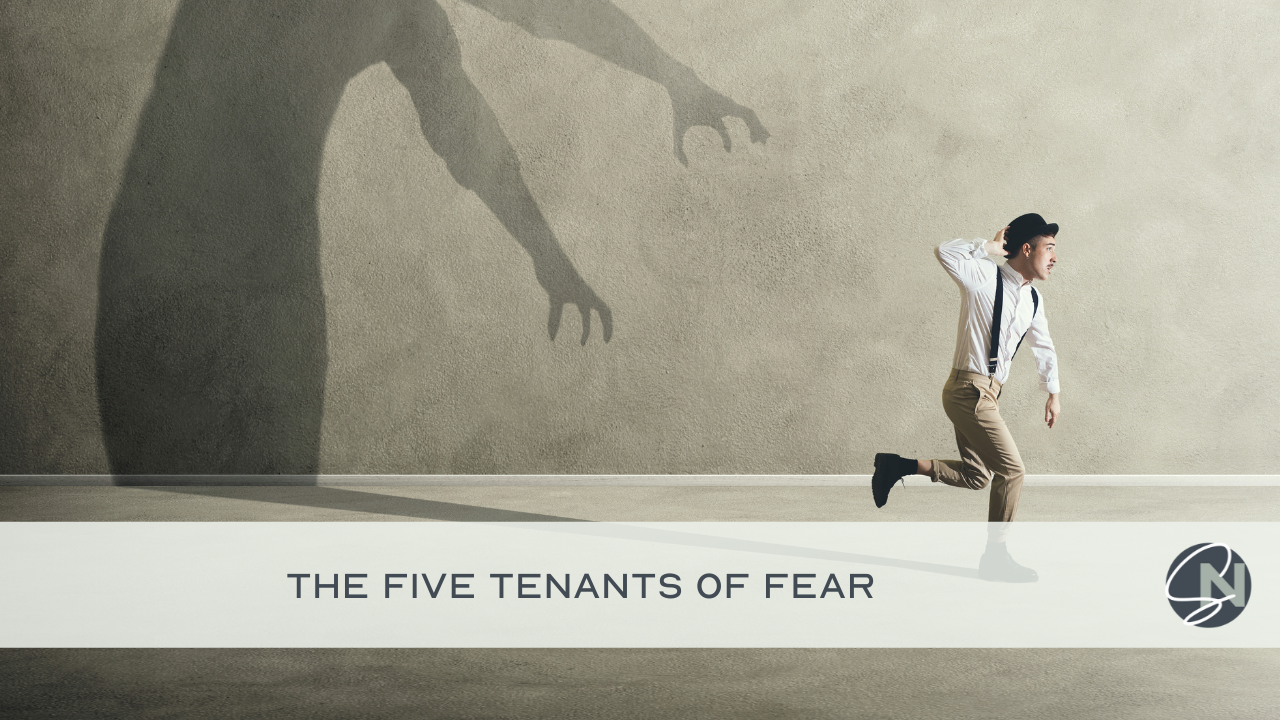The Five Tenants of Fear
A sudden loud noise that makes us jump, a swift movement in the corner of our eye that raises the hair on the back of our neck, or a moment of sheer dread when our heart rises into our throat, and our stomach plummets.
The universal experience of fear serves a very distinct purpose: our basic survival.
Yet, the irony of this emotion is that we are often only aware of its presence after returning to a state of calm and reflecting on our experience. We've all experienced fear. However, are we truly aware of its varying forms, conditions, and intensities?
What does the emotion of fear mean to our sense of safety or personal wellbeing, and what can we do to manage the fear that may seem unfounded and when it doesn't serve us?
"Fear is the path to the Dark Side.
Fear leads to anger, anger leads to hate, hate leads to suffering."
- Yoda
What is Fear?
Fear is an intuitive and spontaneous emotion that leads to adaptive physiological, cognitive, and behavioral responses to a real or perceived threat.
Animal behavior researchers (ethologists) see fear evoked by a threatening situation as a motivational state that results in a defensive behavior - fight - or need to escape - flight.
Across human evolution, fear has allowed us to survive in the most adverse of conditions, for example, a wooly mammoth charging towards us or a natural disaster such as floodwaters or an earthquake.
We can experience fear in various intensities, including trepidation, nervousness, anxiety, dread, desperation, panic, horror, and terror.
Fear can also occur as either innate (natural) or learned (constructed). However, the fear of falling and the fear of loud noises are the only innate or natural fears we are born with.
We observe babies automatically reacting to the potential of either of these scenarios from the second they are born.
In comparison, learned fear is established and reinforced throughout our childhood due to relational, environmental, and cultural influences.
For example, we are not born with an innate fear of spiders or sharks. Instead, this fear occurs because we are taught to respond due to the association between a potential threat or cue (a spider) and a fear outcome (being bit and risk of falling ill).
Depending on how we learn, a potential threat can be genuine, anticipated, or even imagined.
What Purpose Does Fear Serve?
Fear serves as both physical and psychological information for us to determine an appropriate survival response.
In other words, it is the psychobiological reaction to a given threat that occurs automatically. This information can activate our body to respond even before we are cognitively aware of what's happening.
It allows us to perceive a potential threat, regardless of whether we are aware or even familiar with the circumstance, by connecting our innate or learned associations as a conductor on how to respond.
For example, if we find ourselves in an unfamiliar setting or environment, we might experience trepidation or even nervousness, resulting in us proceeding cautiously or with hyper-vigilance.
How We Experience Fear
Fear is a complex phenomenon. Fear of often referred to as either real fear (an actual threat to physical harm) or psychological fear. Real fear triggers a series of physiological, neurological, and psychological responses that result in classic fight, freeze, or flight behaviors.
Psychological fear incorporates elements far more involved than our basic instincts. We are conditioned to prepare for a fear outcome, which in some situations leads to the act of anticipation.
The tricky part is, anticipation does not denote the existence of an actual real threat. This is when we describe the terms of rational or appropriate and irrational or inappropriate fear. It is a subjective expectation of an experience that may or may not occur; however, we constantly initiate a fear response. As a result, there is an increased possibility of chronic physical, neurological and psychological problems.
According to contemporary research on the subject of fear theory, there are five tenants of fear.
The five tenants of fear
1. Fear of Extinction
Often referred to as the fear of death, destruction, or of ceasing to exist. The idea of no longer 'existing' or 'being' can provoke an existential concern for some individuals. Some may experience this fear when faced with heights, expansive spaces, or other cues that stir feelings of our mortality.
2. Fear of Injury or Mutilation
Defined by the fear of losing any part of our precious bodily structure; the thought of having our body's boundaries invaded, or of losing the integrity of any organ, body part, or natural function.
3. Fear of Loss of Autonomy
This fear is all about the thoughts of being immobilized or restricted, entrapped, or otherwise controlled by circumstances beyond our control. In physical form, it's commonly known as claustrophobia, but it also extends to our social interactions and relationships in the form of losing oneself.
4. Fear of Separation or Aloneness
This relates to the association of abandonment, rejection, and loss of connectedness with others. This is because of the fear of becoming a non-person, or someone unwanted, disrespected, or devalued. Anyone who has experienced being shunned or rejected by a group or tribe may experience a significant, adverse psychological reaction.
5. Fear of Ego-Death
A fancy way to describe humiliation, shame, or any other mechanism of profound self-disapproval threatens the self's loss of integrity. Alternatively, it is the fear of shattering or disintegrating one's constructed sense of lovability, capability, and worthiness.
“I'm not afraid of storms, for I'm learning how to sail my ship."
--Louisa May Alcott
What Happens When We Become Fearful?
Like the various physiological, neurological, and psychological responses experienced when we experience anger, our brain triggers the all too familiar fight or flight response.
When we experience fear, two core sections of our brain are activated. The first section to fire up is the amygdala. The amygdala is the neurological center or sensory system for coordinating behavioral, autonomic, and endocrine (hormone) responses to external stimuli (visual, sound, and smell cues). Within milliseconds of the amygdala activating, the following physiological actions occur:
Increase of heart rate and blood pressure;
Pupils dilate to increase sight and input of light;
Blood is redirected to major muscle groups;
Blood-glucose level increases;
Muscles tense, adrenaline and glucose level increase;
Lungs increase oxygen intake;
Nonessential systems (digestion and immune system) shut down to allow more energy for emergency functions;
The other key player is the higher cortical center. This part references cues and memory. For example, it will refer to all of our experiences and knowledge of a potential threat and potentially override the amygdala, allowing us to control our sense of fear.
How Can We Manage Fear?
While we are no longer likely to be threatened by a beastly wooly mammoth, or saber-tooth tiger, experiencing fear is a normal human emotional response.
However, the consequences can be debilitating when we experience fear over a prolonged period, evoked by either a real threat - or an imaginary one. Because we typically recognize fear after the fact, managing fear can be difficult.
While some individuals may believe that fear is the opposite of courage; however, this is incorrect. Courage is a willingness to face adversity, fear is an example of a condition that makes the exercise of courage possible.
How we care for ourselves after the experience is imperative. According to DuPont, Dupont, & DuPont (1998), there are several options to help reduce the impact of a fear experience.
The objective is to condition ourselves to identify and quantify a fear trigger or cue to mitigate its effects. Here are some tactics that can help reduce the impact of fear;
1 - It doesn't matter why you're scared. Knowing why you've developed a particular fear doesn't do much to help you overcome it, and it delays your progress in areas that will actually help you become less afraid. So stop trying to figure it out.
2 - Learn about the thing you fear. Uncertainty is a huge component of fear: Developing an understanding of what you're afraid of goes a long way toward erasing that fear.
3 - Train. If there's something, you're afraid to try because it seems scary or difficult, start small and work in steps. Slowly building familiarity with a frightening subject makes it more manageable.
4 - Find someone who is not afraid. If there's something you're scared of, find someone not scared of that thing and spend time with that person. Then, take them along when you try to conquer your fear.
5 - Talk about it – more than once. Sharing your fears out loud can reduce the scale of the experience. A problem shared is a problem halved.
6 - Play mind games with yourself. For example, if you're afraid of speaking in front of groups, the fear is most likely evoked because of the judgment that you might be anticipating. Try imagining the audience members thinking that you are the subject expert and admire you for doing something daring like getting up behind a podium.
7 - Reduce reflecting on the grand scheme. Instead, reflect on small, successive steps. If you're afraid of heights, don't think about being on the fortieth floor. Just think about getting your foot in the lobby.
8 - Seek help. Fear is not a simple emotion. If you're having trouble overcoming your fear on your own, find a professional to help you. There are many professional treatment options available, and it's possible to overcome fears with the guidance of someone with training and experience.
Fear is the most primary of human emotions. It has served to protect us since the dawn of time and can be both incredibly intense and profound. We all experience fear in some capacity or form, almost daily.
While fear may serve a valid purpose, let's ensure it's not at the expense of your mental and physical wellbeing and your relationships. Regardless of what type of fear you may experience or struggle with, there is a wide range of practical strategies to lessen its impact.
Debrief & Digest
Fear can occur in the form of a natural fight or flight response to either a real (rational) or imaginary (distorted) experience, situation, person, or object.
Fear serves as both physical and psychological information for us to determine an appropriate survival response.
We often experience fear in many emotional experiences, such as fear of isolation, shame, guilt, embarrassment, etc. However, when we explore and acknowledge our fears, it is possible to reduce the impact that they can create.
If you find that fear negatively impacts the quality of your wellbeing and life, then it may be time to engage professional help.
Cheers, Simon
Simon G. Niblock, MA, LMFT, is a licensed psychotherapist, specializing in men’s mental health and wellness. He provides tailored psychotherapy services and online programs for men and is the author of the Anxiety Workbook for Men, Evidence-based Exercises to Manage Anxiety, Depression, and Worry.
Important Notice: The content in this article is for informational purposes only. It does not replace direct professional mental health, medical treatment, or professional care in any way. Seek the support of a physician or other qualified healthcare provider to diagnose and treat any mental health concern directly. Contact 911 or your local emergency services number if you are experiencing a mental health emergency.
References
Albrecht, K (2012) The (Only) 5 Fears We All Share. https://www.psychologytoday.com/blog/brainsnacks/201203/the-only-5-fears-we-all-share
DuPont, Caroline M., DuPont, Robert L., DuPont Spencer, Elizabeth. "The Anxious Brain." The Anxiety Cure: An Eight-Step Program for Getting Well. Wiley, 1998. ISBN 0471247014.
Gibson, E. J., & Walk, R. D. (1960). The visual cliff. Scientific American, 202, 67-71
Kounang, N (2015), What is the science behind fear? http://www.cnn.com/2015/10/29/health/science-of-fear/
Sarhan, A (2013) Fear & Greed Intro and eight practical tips to deal with fear. http://www.globalmacroresearch.com/tag/fear-greed-intro-8-practical-tips-to-deal-with-fear/
Steimer, T. (2002). The biology of fear and anxiety-related behaviors. Dialogues in Clinical Neuroscience, 4(3), 231–249. https://www.ncbi.nlm.nih.gov/pmc/articles/PMC3181681/

